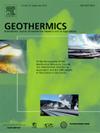Reaction between in-situ generated acid and carbonate rock at ultra-high temperatures: A fusion of kinetic mechanisms and experiments
IF 3.5
2区 工程技术
Q3 ENERGY & FUELS
引用次数: 0
Abstract
With the advancement of exploration, carbonate resource development has progressed to ultra-deep layers, with reservoir temperatures rising to ultra-high levels (>180 °C). Effective acid fracturing under such conditions requires optimizing acid formulations and understanding acid-rock reaction mechanisms. This study optimized the formulation of in-situ generated acid for ultra-high temperatures and analyzed its acidogenic properties, dissolving capacity. The acid-rock reaction rate was measured using Rotating Disk Apparatus (RDA) and the effect of different factors on the reaction rate was analyzed. Experimental results showed that the optimal acid formulation involved a 1:1.5 molar ratio of ammonium chloride (NH4Cl) to polyformaldehyde (POM) and a total concentration of 30 %. Acidogenic concentration initially increased rapidly, plateaued, and declined at higher temperatures due to formaldehyde volatilization and decomposition. At 180 °C, higher acid concentrations enhanced reaction rates, intensifying surface etching on limestone and dolomite. Reaction rates decreased with rising temperatures, primarily governed by acidogenic concentration. Increased rotational speed transformed the surface from flat to rough, forming central humps and cavities, with etching pits extending from rock edge to center. Linear velocity significantly influenced reaction rates and etching patterns. Larger cores experienced higher linear velocities at the same rotational speed, resulting to increased reaction rates without area-volume ratio corrections. After correction, differences in reaction rates across core sizes were significantly reduced, with etching morphologies at lower speeds resembling those of smaller cores at higher speeds. This work provided theoretical support for the application of in-situ generated acid in acid fracturing of ultra-high temperature carbonate reservoirs.

超高温下原位生成酸与碳酸盐岩的反应:动力学机制与实验的融合
随着勘探的深入,碳酸盐岩资源开发已向超深层发展,储层温度升至超高水平(>180℃)。在这种条件下进行有效的酸压裂需要优化酸配方并了解酸岩反应机制。本研究对超高温原位生成酸的配方进行了优化,并对其产酸性能、溶解能力进行了分析。采用旋转圆盘仪(RDA)测定了酸岩反应速率,并分析了不同因素对反应速率的影响。实验结果表明,氯化铵(NH4Cl)与聚甲醛(POM)的摩尔比为1:1.5,总浓度为30%,为最佳酸配方。在较高温度下,由于甲醛的挥发和分解,致酸浓度开始迅速上升,趋于稳定,然后下降。在180°C时,较高的酸浓度提高了反应速率,加剧了石灰石和白云石的表面腐蚀。反应速率随温度升高而降低,主要受致酸浓度的影响。旋转速度的增加使表面由平坦变为粗糙,形成中央隆起和空洞,蚀刻坑从岩石边缘延伸到中心。线速度显著影响反应速率和蚀刻图案。在相同的转速下,更大的岩心经历了更高的线速度,从而在没有面积体积比修正的情况下提高了反应速率。修正后,不同尺寸的岩心反应速率的差异显著减小,较低速度下的蚀刻形貌与较高速度下较小岩心的蚀刻形貌相似。为原位产酸在超高温碳酸盐岩储层酸压中的应用提供了理论支持。
本文章由计算机程序翻译,如有差异,请以英文原文为准。
求助全文
约1分钟内获得全文
求助全文
来源期刊

Geothermics
工程技术-地球科学综合
CiteScore
7.70
自引率
15.40%
发文量
237
审稿时长
4.5 months
期刊介绍:
Geothermics is an international journal devoted to the research and development of geothermal energy. The International Board of Editors of Geothermics, which comprises specialists in the various aspects of geothermal resources, exploration and development, guarantees the balanced, comprehensive view of scientific and technological developments in this promising energy field.
It promulgates the state of the art and science of geothermal energy, its exploration and exploitation through a regular exchange of information from all parts of the world. The journal publishes articles dealing with the theory, exploration techniques and all aspects of the utilization of geothermal resources. Geothermics serves as the scientific house, or exchange medium, through which the growing community of geothermal specialists can provide and receive information.
 求助内容:
求助内容: 应助结果提醒方式:
应助结果提醒方式:


